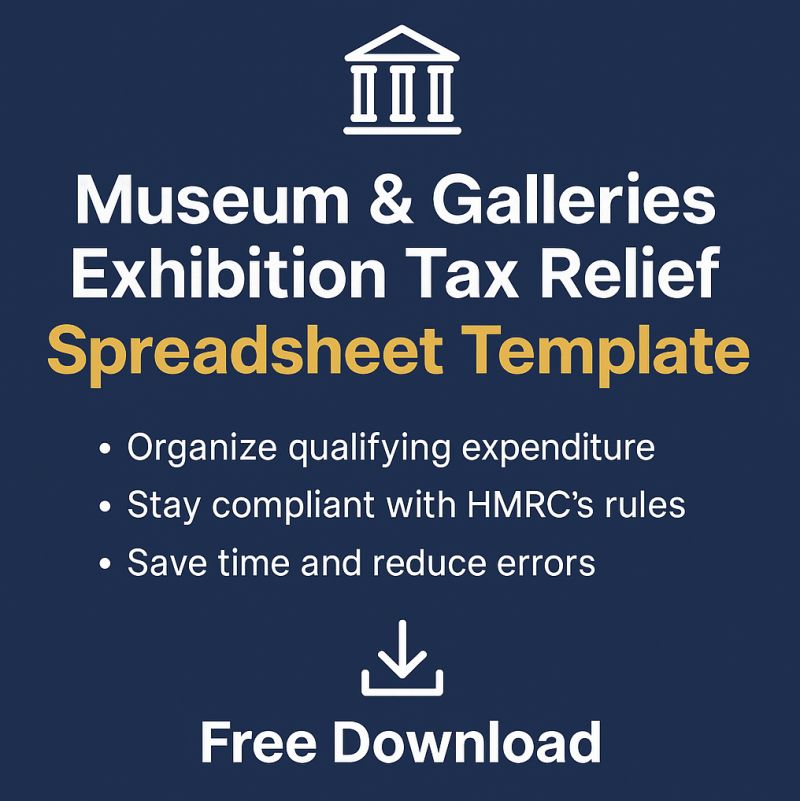Museums and Galleries Exhibition Tax Relief (MGETR) is a government funding incentive currently worth up to 40% of core production costs. MGETR helps qualifying production companies offset some of the costs of their exhibitions, supporting new collections and reaching wider audiences.

MGETR is a valuable funding opportunity for museums and galleries, helping them create engaging exhibitions for the public.
MGETR supports museums and galleries to develop new permanent and temporary exhibitions for the benefit of the general public.
Unlike some other creative tax reliefs, there is no requirement for certification via a cultural test. However, MGETR is only available to charities or local authorities.


Museums and Galleries Exhibition Tax Relief is currently worth up to 40% of production costs.
Depending on your accounting period, you will only be able to claim for European expenditure or UK expenditure. Accounting periods beginning on or after 1 April 2024 can only claim for UK expenditure; before this will be UK or EEA expenditure.
Your accounting period will also decide which minimum core expenditure requirement you need to follow.
MGETR can be claimed as a reduction in Corporation Tax credit. However, loss-making companies can surrender their losses for a cash credit!
Current cash credit rates are:
Primary and secondary production companies can claim for MGETR, so long as they meet the basic requirements.
To qualify, your company must meet the following conditions:
For more details on primary and secondary production companies, check out our FAQs.


You’ll need to check that your production qualifies, too.
The first thing to check is that your exhibition is a curated display of a collection (or of a single object) considered to be of scientific, historic, artistic or cultural interest.
The exhibition must be intended to be open to the general public, irrespective of admission charge.
At least 25% of your core production expenditure is within the UK and/or European Economic Area (EEA). From 1 April 2024, a new rule replaces this condition: 10% of expenditure must be in the UK.
In our latest MGETR eBook, we explain how you can make the most of this valuable government programme.
This free eBook, created by Myriad’s expert team, provides clear, expert guidance on how to claim MGETR and secure your entitlement.


Simplify your Museums & Galleries Exhibition Tax Relief (MGETR) claim with Myriad’s MGETR costing by trade spreadsheet. A powerful, structured template designed to help you satisfy HMRC cost reporting requirements.
Museums and Galleries Exhibition Tax Relief is claimed as part of the Company Tax Return (CT600) filed with HMRC. You’ll need to elect to treat all costs related to the exhibition as a separate trade.
You need to submit the following information alongside the CT600:
You’ll need to calculate if your exhibition has made a profit or a loss. This lets you determine whether you can claim MGETR as a reduction in Corporation Tax or if your losses should be surrendered for a cash repayment.


To claim the higher rate for touring exhibitions, your exhibition must:
The key to when core costs can be claimed is knowing when the project was “green-lit”. Initial concept design is usually undertaken to determine whether the exhibition is commercially feasible. Any expenditure in this stage is speculative in nature.
Once it is clear that the exhibition is going ahead, expenditure can be claimed. Some production companies may have very little conceptual development before proceeding with production, and some may spend more time assessing the commercial viability of an exhibition.
Qualifying costs are referred to as core expenditure. This includes the spending on:
Storage expenditure is allowed as core expenditure for up to 4 months if all of these conditions are met:
Core expenditure does not include:
The Primary Production Company (PPC) is responsible for organising an exhibition at the first (if touring) or only venue (if not touring). It must also be responsible for creative and technical decisions, contractual agreements, and producing, running and closing the exhibition at this venue.
A Secondary Production Company (SPC) is responsible for organising an exhibition at the second or subsequent venues for a touring exhibition. It must be responsible for producing, running and closing the exhibition at that venue.
A SPC can only make a claim if there is a PPC.
The maximum repayable credit is capped at £100,000 for touring exhibitions and £80,000 for non-touring exhibitions.
There is no cap on the amount that can be claimed as a reduction in Corporation Tax.
Some exhibitions may meet the qualifying criteria, but are not eligible if they meet any of the below conditions:
Core expenditure must be apportioned on a “fair and reasonable basis". There are multiple ways you can define this, depending on the cost. You may wish to explain your methodology to HMRC to ensure you meet this criterion.
As with core and non-core expenditure, you will need to apportion UK/EEA and non-UK/EEA expenditure. Workers based in a UK/EEA office or working remotely in the UK/EEA can be included, for example, but workers physically outside of the UK/EEA are ineligible. This applies regardless of where the company is based, the worker’s nationality or whether the company is in a group with the claimant.
For some costs that are partly based in the UK/EEA, you can choose how to apportion the cost. For example, a staff member who works partly in the UK/EEA will only be eligible for the number of days they are working there.
For accounting periods beginning before 1 April 2024, you may make your claim up to one year after the company’s filing date.
For accounting periods beginning on or after 1 April 2024, you may make your claim up to 2 years after the end of the period of account.